Analysis of Landscape Change and Its Driving Mechanism in Chagan Lake National Nature Reserve
Abstract
:1. Introduction
2. Materials and Methods
2.1. Study Area
2.2. Data Sources
2.3. Process and Methods
2.3.1. Landscape Classification
2.3.2. Selection of Landscape Metrics
2.3.3. Land-Use Transfer Matrix
2.3.4. Selection of Driving Forces
2.3.5. Analysis of Driving Factors, Based on Geographically Weighted Regression (GWR)
- Spatial sample selection
- GWR model test—ordinary least squares (OLS) regression
- GWR model formulation
2.3.6. Geographical Detector Model Formulation
- The factor detector detects the spatial divergence of Y and the degree of explanation of factor X to the spatial divergence of attribute Y. Measured by the value q, the expression is as follows:
- The interactive detector evaluates the changes in the degree of interpretation of the combined effect of factors X1 and X2 relative to the single-factor effect. First, we calculate the interpretation degrees of two factors X1 and X2 for Y: q(X1) and q(X2), then we calculate the interpretation degrees q(X1∩X2) when they interact, and finally, q(X1), q(X2) and q(X1∩X2) are compared. The types of interaction between the two factors are as follows (see Figure 5).
3. Results
3.1. Changes in Landscape Pattern
3.1.1. Dynamic Changes of Landscape Types
3.1.2. Land-Use Transfer Matrix
3.1.3. Changes in Landscape Metrics
3.2. Analysis of the Driving Factors of Landscape Change
3.2.1. Spatial Heterogeneity Analysis of the Impact of Natural Factors on Landscape Change
3.2.2. Spatial Heterogeneity Analysis of the Impact of Socio-Economic Factors on Landscape Change
3.3. Analysis of the Driving Mechanism of Land-Use Change
3.3.1. The Factor Detector
3.3.2. The Interaction Detector
4. Discussion
4.1. Characteristics of Landscape Pattern Change in the Study Area
4.2. The Driving Mechanisms
4.3. Implications for the Lake’s Protection and Management
4.4. Limitations of the Current Research
5. Conclusions
- In the past 15 years, the main land types in Chagan Lake Nature Reserve were lakes and grasslands, accounting for more than 66% of the total area. The area of lakes increased, while the area of bare land decreased, and the ecological environment has been gradually restored. On the other hand, due to the enhancement of landscape connectivity and the increase of the cultivated land area, a large amount of irrigation has increased the fluorine content in Chagan Lake.
- The temporal and spatial differentiation patterns of the different driving factors of landscape change in Chagan Lake Nature Reserve are diverse. The regression coefficients of P and LFC are large, showing a strong driving force on landscape change. Because the annual precipitation increased year by year during the study period, which is conducive to the growth of vegetation and lake-water storage, this promoted changes in the landscape types, such as grasslands and water areas. At the same time, the study area is located in a typical fluorine-rich geochemical environment. Human activities, such as the expansion of irrigation areas around Chagan Lake, have changed the original hydrological and water-quality environment and promoted the enrichment process of fluorine in Chagan Lake, enhancing the explanatory power of the lake’s fluorine content.
- The driving factors leading to landscape change in Chagan Lake Nature Reserve were different in each period. From 2005 to 2010, the landscape change was mainly affected by LFC, while from 2010 to 2015, it was mainly affected by P. The interaction between P and LFC and other factors showed a strong driving effect, which was an important factor affecting landscape change. From 2015 to 2019, the landscape change in Chagan Lake Nature Reserve was not dominated by individual factors; however, the interaction force of precipitation and the gross domestic product was the largest.
Author Contributions
Funding
Data Availability Statement
Acknowledgments
Conflicts of Interest
References
- Kong, F.; Min, X.; Yue, L.; Kong, F.; Wan, C. Wetland landscape pattern change based on GIS and RS: A review. Chin. J. Appl. Ecol. 2013, 24, 941–946. [Google Scholar]
- Alvarez, D.; Corsi, S.; De Cicco, L.; Villeneuve, D.; Baldwin, A. Identifying Chemicals and Mixtures of Potential Biological Concern Detected in Passive Samplers from Great Lakes Tributaries Using High-Throughput Data and Biological Pathways. Environ. Toxicol. Chem. 2021, 40, 2165–2182. [Google Scholar] [CrossRef] [PubMed]
- Ducey, M.; Johnson, K.; Belair, E.; Cook, B. The Influence of Human Demography on Land Cover Change in the Great Lakes States, USA. Environ. Manag. 2018, 62, 1089–1107. [Google Scholar] [CrossRef] [PubMed]
- Liu, L.; Dong, Y.; Kong, M.; Zhou, J.; Zhao, H.; Tang, Z.; Zhang, M.; Wang, Z. Insights into the long-term pollution trends and sources contributions in Lake Taihu, China using multi-statistic analyses models. Chemosphere 2020, 242, 125272. [Google Scholar] [CrossRef]
- Zhang, T.; Hu, H.; Ma, X.; Zhang, Y. Long-Term Spatiotemporal Variation and Environmental Driving Forces Analyses of Algal Blooms in Taihu Lake Based on Multi-Source Satellite and Land Observations. Water 2020, 12, 1035. [Google Scholar] [CrossRef] [Green Version]
- Zhang, F.; Yushanjiang, A.; Jing, Y. Assessing and predicting changes of the ecosystem service values based on land use/cover change in Ebinur Lake Wetland National Nature Reserve, Xinjiang, China. Sci. Total Environ. 2019, 656, 1133–1144. [Google Scholar] [CrossRef]
- Liang, J.; Li, X. Characteristics of temporal-spatial differentiation in landscape pattern vulnerability in Nansihu Lake wetland, China. J. Appl. Ecol. 2018, 29, 626. [Google Scholar]
- Liu, X.; Zhang, Y.; Dong, G.; Hou, G.; Jiang, M. Landscape pattern changes in the Xingkai Lake Area, northeast China. Int. J. Environ. Res. Public Health 2019, 16, 3820. [Google Scholar] [CrossRef] [Green Version]
- Zhong, Y.; Lin, A.; Zhou, Z. Evolution of the pattern of spatial expansion of urban land use in the Poyang Lake ecological economic zone. Int. J. Environ. Res. Public Health 2019, 16, 117. [Google Scholar] [CrossRef] [Green Version]
- Li, L.; Su, F.; Brown, M.; Liu, H.; Wang, T. Assessment of ecosystem service value of the Liaohe estuarine wetland. Appl. Sci. 2018, 8, 2561. [Google Scholar] [CrossRef] [Green Version]
- Zhou, J.; Wu, J.; Gong, Y. Valuing wetland ecosystem services based on benefit transfer: A meta-analysis of China wetland studies. J. Clean. Prod. 2020, 276, 11. [Google Scholar] [CrossRef]
- Zhang, L.; Cai, Y.; Jiang, M.; Dai, J.; Guo, X.; Li, W.; Li, Y. The levels of microbial diversity in different water layers of saline Chagan Lake, China. J. Oceanol. Limnol. 2020, 38, 395–407. [Google Scholar] [CrossRef]
- Haliuc, A.; Buczko, K.; Hutchinson, S.; Acs, E.; Magyari, E.; Korponai, J.; Begy, R.-C.; Vasilache, D.; Zak, M.; Veres, D. Climate and land-use as the main drivers of recent environmental change in a mid altitude mountain lake, Romanian Carpathians. PLoS ONE 2020, 15, e0239209. [Google Scholar] [CrossRef]
- Chu, L.; Sun, T.; Wang, T.; Li, Z.; Cai, C. Evolution and prediction of landscape pattern and habitat quality based on ca-markov and invest model in Hubei section of Three Gorges reservoir area (TGRA). Sustainability 2018, 10, 3854. [Google Scholar] [CrossRef] [Green Version]
- Zhang, Y.; Qu, J.; Li, D. Evolution and prediction of coastal wetland landscape pattern: An exploratory study. J. Coastal. Res. 2020, 106, 553–556. [Google Scholar] [CrossRef]
- Zhao, H.; Zheng, H.; Miao, C.; Shao, T.; Feng, Y. Spatial-temporal pattern and factor diagnoses of agroecosystem health in major grain producing areas of Northeast China: A case study in Jilin Province. Chin. J. Appl. Ecol. 2016, 27, 3290–3298. [Google Scholar]
- Bie, Q.; Xie, Y. The constraints and driving forces of oasis development in arid region: A case study of the Hexi Corridor in northwest China. Sci. Rep. 2020, 10, 17708. [Google Scholar] [CrossRef]
- Xiao, M.; Zhang, Q.; Qu, L.; Hussain, H.; Dong, Y.; Zheng, L. Spatiotemporal changes and the driving forces of sloping farmland areas in the Sichuan region. Sustainability 2019, 11, 906. [Google Scholar] [CrossRef] [Green Version]
- Wang, B.; Li, Y.; Wang, S.; Liu, C.; Zhu, G.; Liu, L. Oasis landscape pattern dynamics in Manas River watershed based on remote sensing and spatial metrics. J. Indian Soc. Remote 2019, 47, 153–163. [Google Scholar] [CrossRef]
- Liu, C.; Zhang, F.; Johnson, V.; Duan, P.; Kung, H. Spatio-temporal variation of oasis landscape pattern in arid area: Human or natural driving? Ecol. Indic. 2021, 125, 14. [Google Scholar] [CrossRef]
- Shifaw, E.; Sha, J.; Li, X. Detection of spatiotemporal dynamics of land cover and its drivers using remote sensing and landscape metrics (Pingtan Island, China). Environ. Dev. Sustain. 2020, 22, 1269–1298. [Google Scholar] [CrossRef]
- Lewandowska-Gwarda, K. Geographically Weighted Regression in the Analysis of Unemployment in Poland. ISPRS Int. J. Geo-Inf. 2018, 7, 17. [Google Scholar] [CrossRef] [Green Version]
- Fotheringham, A.S.; Oshan, T.M. Geographically weighted regression and multicollinearity: Dispelling the myth. J. Geogr. Syst. 2016, 18, 303–329. [Google Scholar] [CrossRef]
- Ju, H.; Zhang, Z.; Zuo, L.; Wang, J.; Zhang, S.; Wang, X.; Zhao, X. Driving forces and their interactions of built-up land expansion based on the geographical detector—A case study of Beijing, China. Int. J. Geogr. Inf. Sci. 2016, 30, 2188–2207. [Google Scholar] [CrossRef]
- Liu, Y.; Cao, X.; Li, T. Identifying Driving Forces of Built-Up Land Expansion Based on the Geographical Detector: A Case Study of Pearl River Delta Urban Agglomeration. Int. J. Environ. Res. Public Health 2020, 17, 1759. [Google Scholar] [CrossRef] [PubMed] [Green Version]
- Li, J.; Sun, Z. Urban function orientation based on spatiotemporal differences and driving factors of urban construction land. J. Urban Plan. Dev. 2020, 146, 05020011. [Google Scholar] [CrossRef]
- Meng, X.; Gao, X.; Li, S.; Lei, J. Spatial and temporal characteristics of vegetation NDVI changes and the driving forces in Mongolia during 1982–2015. Remote Sens. 2020, 12, 603. [Google Scholar] [CrossRef] [Green Version]
- Yan, J.; Chen, J.; Zhang, W.; Ma, F. Determining fluoride distribution and influencing factors in groundwater in Songyuan, Northeast China, using hydrochemical and isotopic methods. J. Geochem. Explor. 2020, 217, 106605. [Google Scholar] [CrossRef]
- Zhao, W.; Xiao, C.; Chai, Y.; Feng, X.; Liang, X.; Fang, Z. Application of a new improved weighting method, ESO method combined with fuzzy synthetic method, in water quality evaluation of Chagan Lake. Water 2021, 13, 1424. [Google Scholar] [CrossRef]
- Liu, X.; Zhang, G.; Sun, G.; Wu, Y.; Chen, Y. Assessment of lake water quality and eutrophication risk in an agricultural irrigation area: A case study of the Chagan Lake in northeast China. Water 2019, 11, 2380. [Google Scholar] [CrossRef] [Green Version]
- Li, S.; Song, K.; Zhao, Y.; Mu, G.; Shao, T.; Ma, J. Absorption characteristics of particulates and CDOM in waters of Chagan Lake and Xinlicheng Reservoir in autumn. Huan Jing Ke Xue 2016, 37, 112–122. [Google Scholar] [PubMed]
- Liu, X.; Zhang, G.; Zhang, J.; Xu, Y.; Wu, Y.; Wu, Y.; Sun, G.; Chen, Y.; Ma, H. Effects of irrigation discharge on salinity of a large freshwater lake: A case study in Chagan Lake, Northeast China. Water 2020, 12, 2112. [Google Scholar] [CrossRef]
- Tang, J.; Dai, Y.; Wang, J.; Qu, Y.; Liu, B.; Duan, Y.; Li, Z. Study on environmental factors of fluorine in Chagan Lake catchment, Northeast China. Water 2021, 13, 629. [Google Scholar] [CrossRef]
- Xu, P.; Bian, J.; Wu, J.; Li, Y.; Ding, F. Distribution of fluoride in groundwater around Chagan Lake and its risk assessment under the influence of human activities. Water Sci. Tech-Water Supply 2020, 20, 2441–2454. [Google Scholar] [CrossRef]
- Liu, P.; Zheng, C.; Wen, M.; Luo, X.; Wu, Z.; Liu, Y.; Chai, S.; Huang, L. Ecological risk assessment and contamination history of heavy metals in the sediments of Chagan Lake, Northeast China. Water 2021, 13, 894. [Google Scholar] [CrossRef]
- Wang, F.; Ding, Q.; Zhang, L.; Wang, M.; Wang, Q. Analysis of Land Surface Deformation in Chagan Lake Region Using TCPInSAR. Sustainability 2019, 11, 5090. [Google Scholar] [CrossRef] [Green Version]
- Yaseen, S.; Shaban, A. Detection of altered water content of AlHammar marshes. In Technologies and Materials for Renewable Energy, Environment and Sustainability; Salame, C.T., Shaban, A., Jabur, A.R., Haider, A.J., Eds.; Elsevier: Amsterdam, The Netherlands, 2020; Volume 2307. [Google Scholar]
- Hecher, J.; Filippi, A.; Guneralp, I.; Paulus, G. Extracting River Features from Remotely Sensed Data: An Evaluation of Thematic Correctness. In GI_Forum 2013, Creating the GISociety—Conference Proceedings; Wichmann: Berlin, Germany, 2013. [Google Scholar]
- Zhou, Z.; Li, J. The correlation analysis on the landscape pattern index and hydrological processes in the Yanhe watershed, China. J. Hydrol. 2015, 524, 417–426. [Google Scholar] [CrossRef]
- Yushanjiang, A.; Zhang, F.; Yu, H.; Kung, H. Quantifying the spatial correlations between landscape pattern and ecosystem service value: A case study in Ebinur Lake Basin, Xinjiang, China. Ecol. Eng. 2018, 113, 94–104. [Google Scholar] [CrossRef]
- Bell, E.J. Markov analysis of land use change—Application of stochastic processes to remotely sensed data. Socio-Econ. Plan. Sci. 1974, 8, 311–316. [Google Scholar] [CrossRef]
- Shi, G.; Ye, P.; Ding, L.; Quinones, A.; Li, Y.; Jiang, N. Spatio-temporal patterns of land use and cover change from 1990 to 2010: A case study of Jiangsu province, China. Int. J. Environ. Res. Public Health 2019, 16, 907. [Google Scholar] [CrossRef] [Green Version]
- Yang, X.; Zheng, X.; Lv, L. A spatiotemporal model of land use change based on ant colony optimization, Markov chain and cellular automata. Ecol. Model. 2012, 233, 11–19. [Google Scholar] [CrossRef]
- Li, C.; Li, F.; Wu, Z.; Cheng, J. Exploring spatially varying and scale-dependent relationships between soil contamination and landscape patterns using geographically weighted regression. Appl. Geogr. 2017, 82, 101–114. [Google Scholar] [CrossRef]
- Liu, C.; Wu, X.; Wang, L. Analysis on land ecological security change and affect factors using RS and GWR in the Danjiangkou Reservoir area, China. Appl. Geogr. 2019, 105, 1–14. [Google Scholar] [CrossRef]
- Yang, C.; Li, R.; Sha, Z. Exploring the dynamics of urban greenness space and their driving factors using geographically weighted regression: A case study in Wuhan metropolis, China. Land 2020, 9, 500. [Google Scholar] [CrossRef]
- Taillefumier, F.; Piégay, H. Contemporary land use changes in prealpine Mediterranean mountains: A multivariate gis-based approach applied to two municipalities in the Southern French Prealps. Catena 2003, 51, 267–296. [Google Scholar] [CrossRef]
- Wang, J.; Cai, X.; Chen, F.; Zhang, Z.; Zhang, Y.; Sun, K.; Zhang, T.; Chen, X. Hundred-year spatial trajectory of lake coverage changes in response to human activities over Wuhan. Environ. Res. Lett. 2020, 15, 094022. [Google Scholar] [CrossRef]
- Cao, F.; Ge, Y.; Wang, J. Optimal discretization for geographical detectors-based risk assessment. Gisci. Remote Sens. 2013, 50, 78–92. [Google Scholar] [CrossRef]
- Fang, H.; He, Z.; Chen, Q.; Xia, T. Analysis on the temporal and spatial changes of Chagan Lake and its response to precipitation changes during 1985–2018. Sci. Agric. Info. 2020, 32, 64–73. [Google Scholar]
- Li, Y.; Shi, K.; Zhang, Y.; Zhu, G.; Li, N. Analysis of Water Clarity Decrease in Xin’anjiang Reservoir, China, from 30-Year Landsat TM, ETM+, and OLI Observations. J. Hydrol. 2020, 590, 125476. [Google Scholar] [CrossRef]
- Karaya, R.N.; Onyango, C.A.; Ogendi, G.M. A community-GIS supported dryland use and cover change assessment: The case of the Njemps flats in Kenya. Cogent Food Agric. 2021, 7, 1872852. [Google Scholar] [CrossRef]
- Hao, C.; Wanchang, Z.; Huiran, G.; Ning, N. Climate Change and Anthropogenic Impacts on Wetland and Agriculture in the Songnen and Sanjiang Plain, Northeast China. Remote Sens. 2018, 10, 356. [Google Scholar]
- Balkanlou, K.; Müller, B.; Cord, A.; Panahi, F.; Egli, L. Spatiotemporal dynamics of ecosystem services provision in a degraded ecosystem: A systematic assessment in the Lake Urmia basin, Iran. Sci. Total Environ. 2020, 716, 137100. [Google Scholar] [CrossRef] [PubMed]

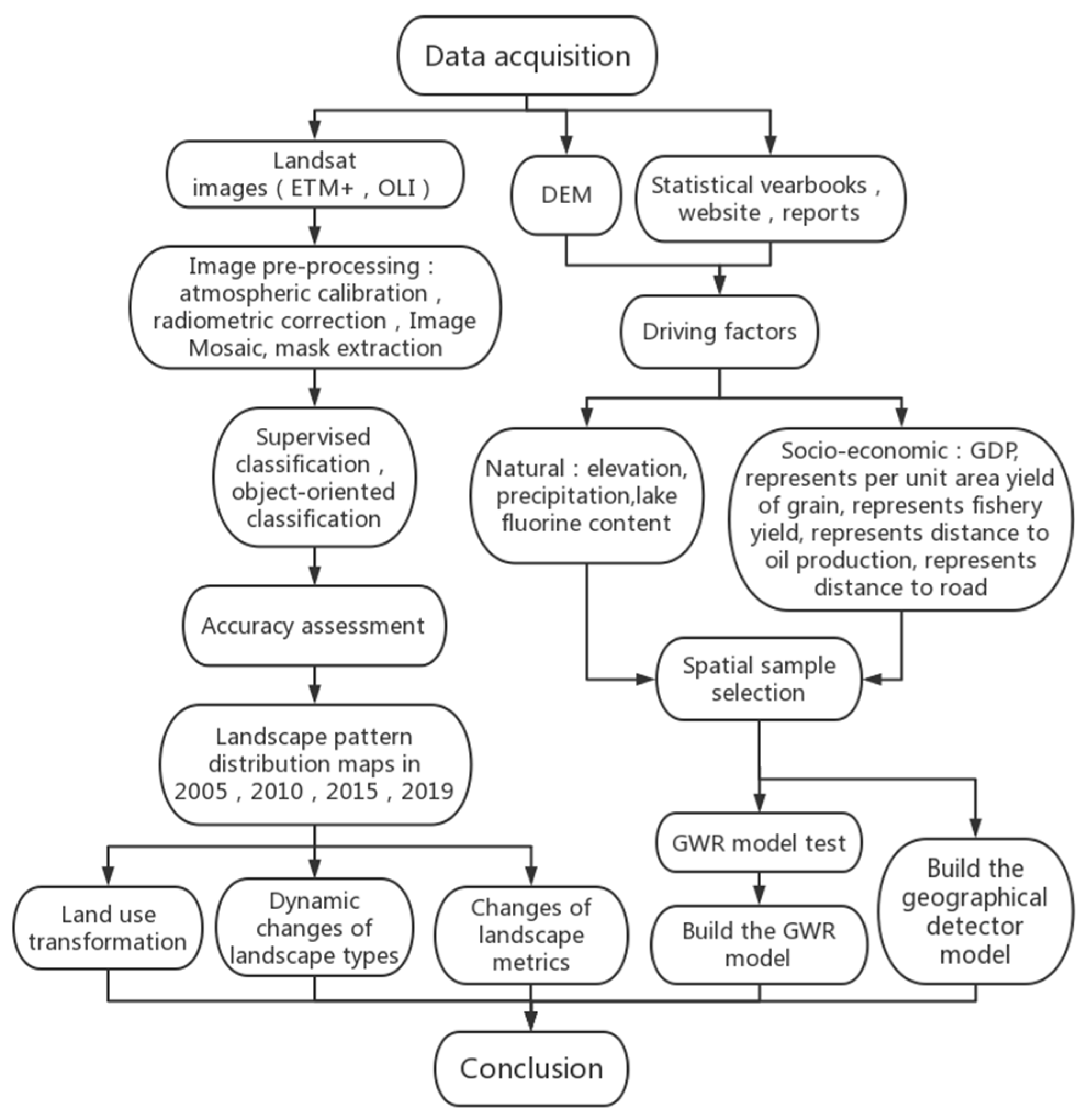

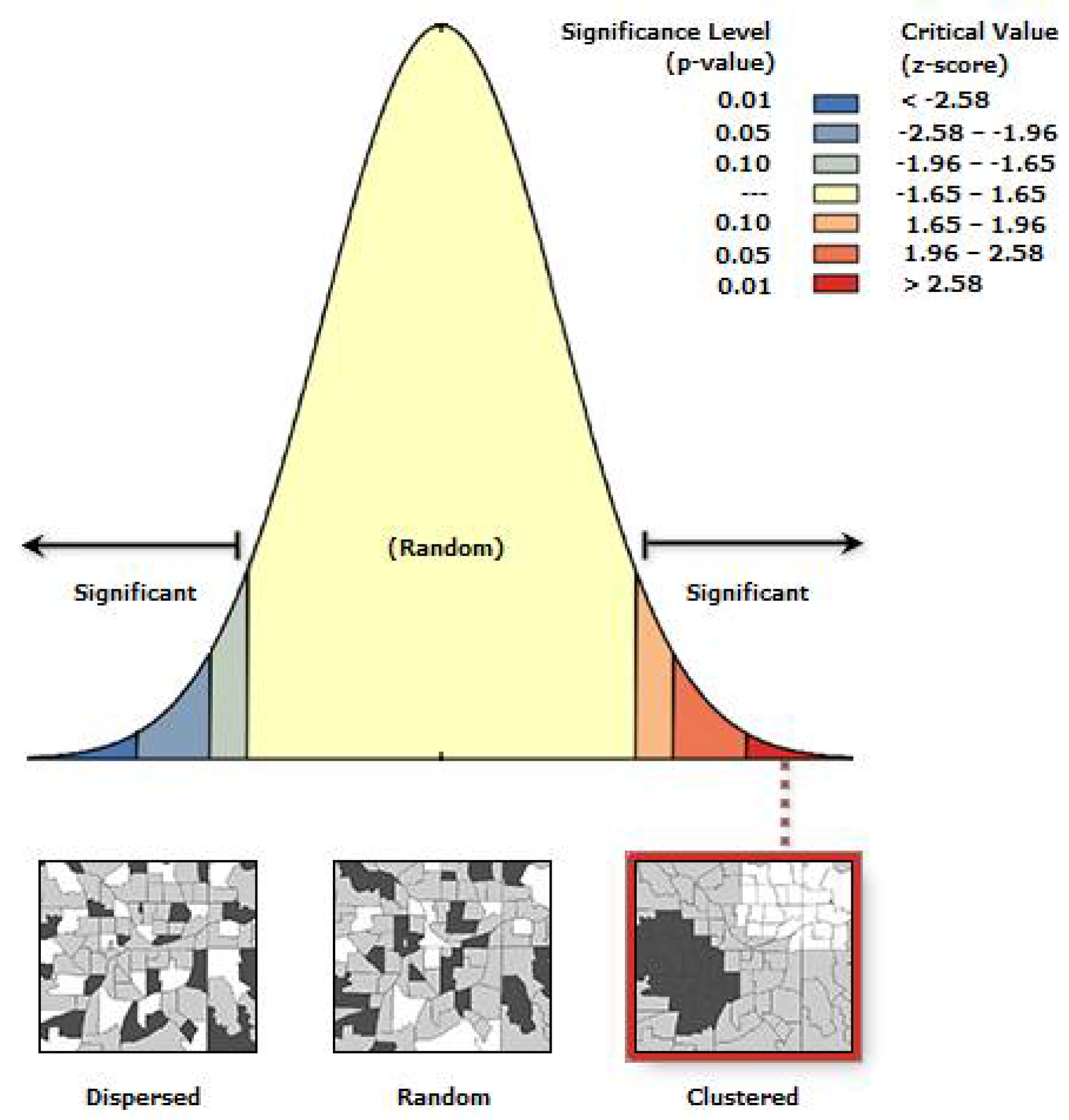



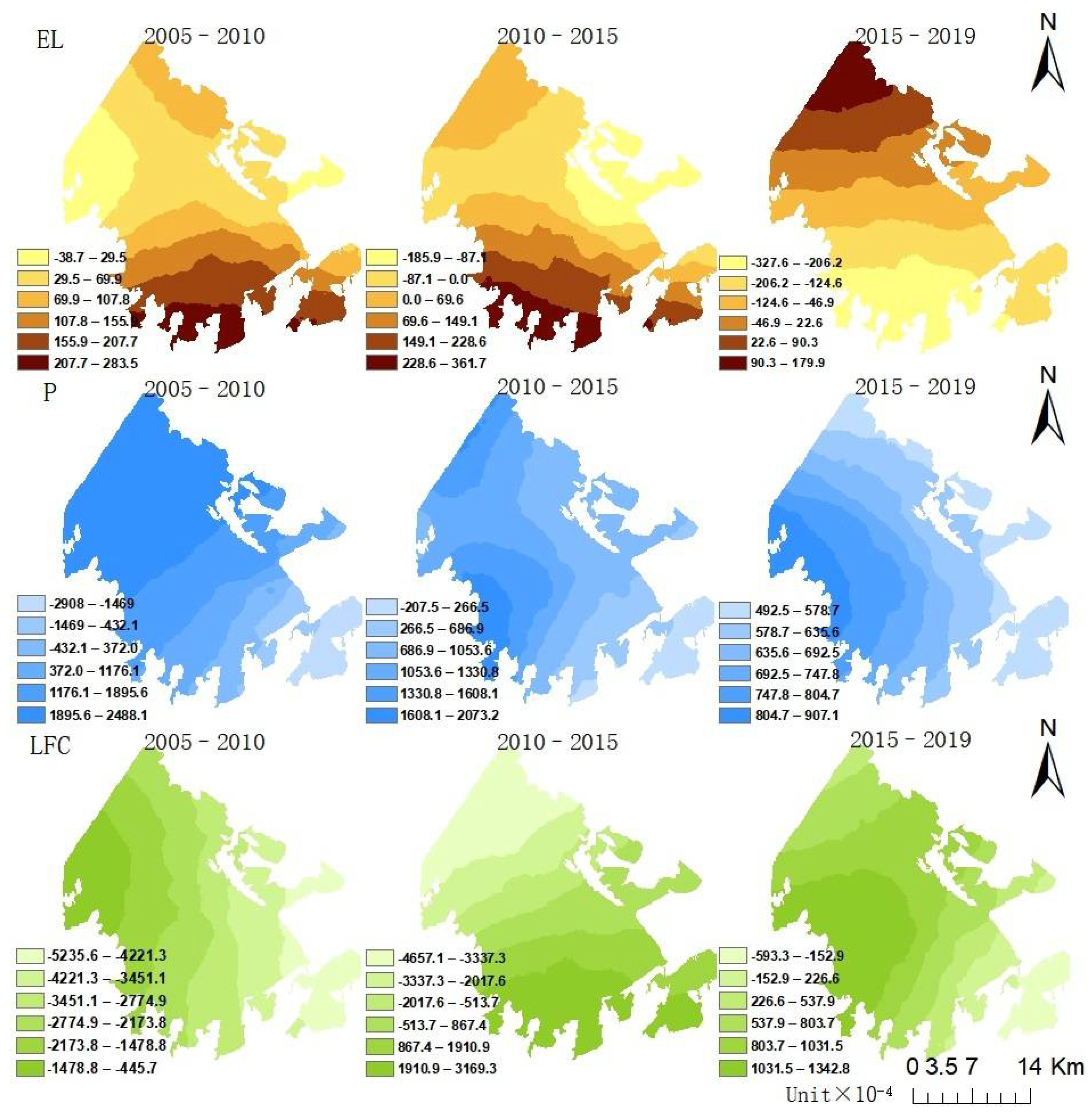
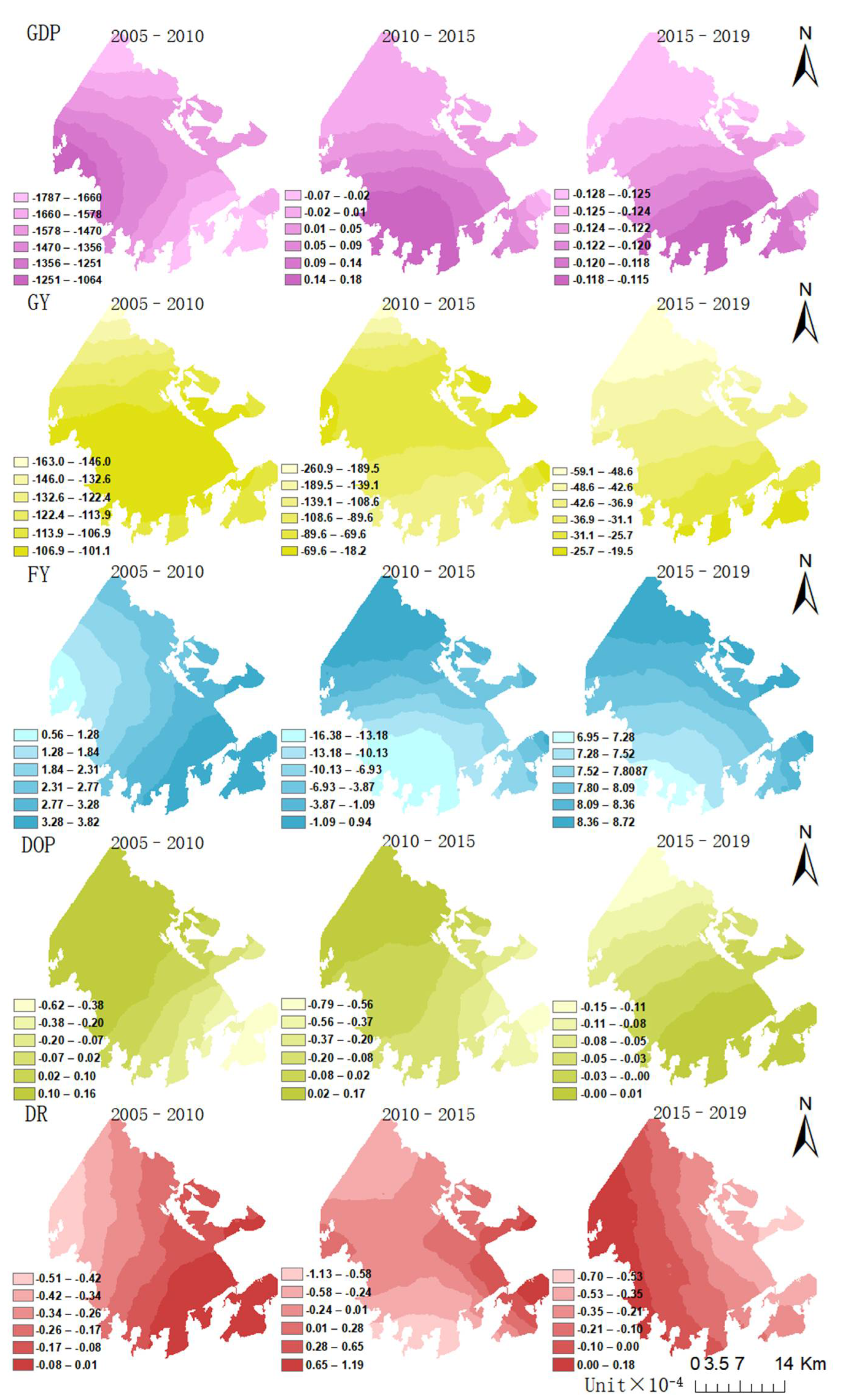
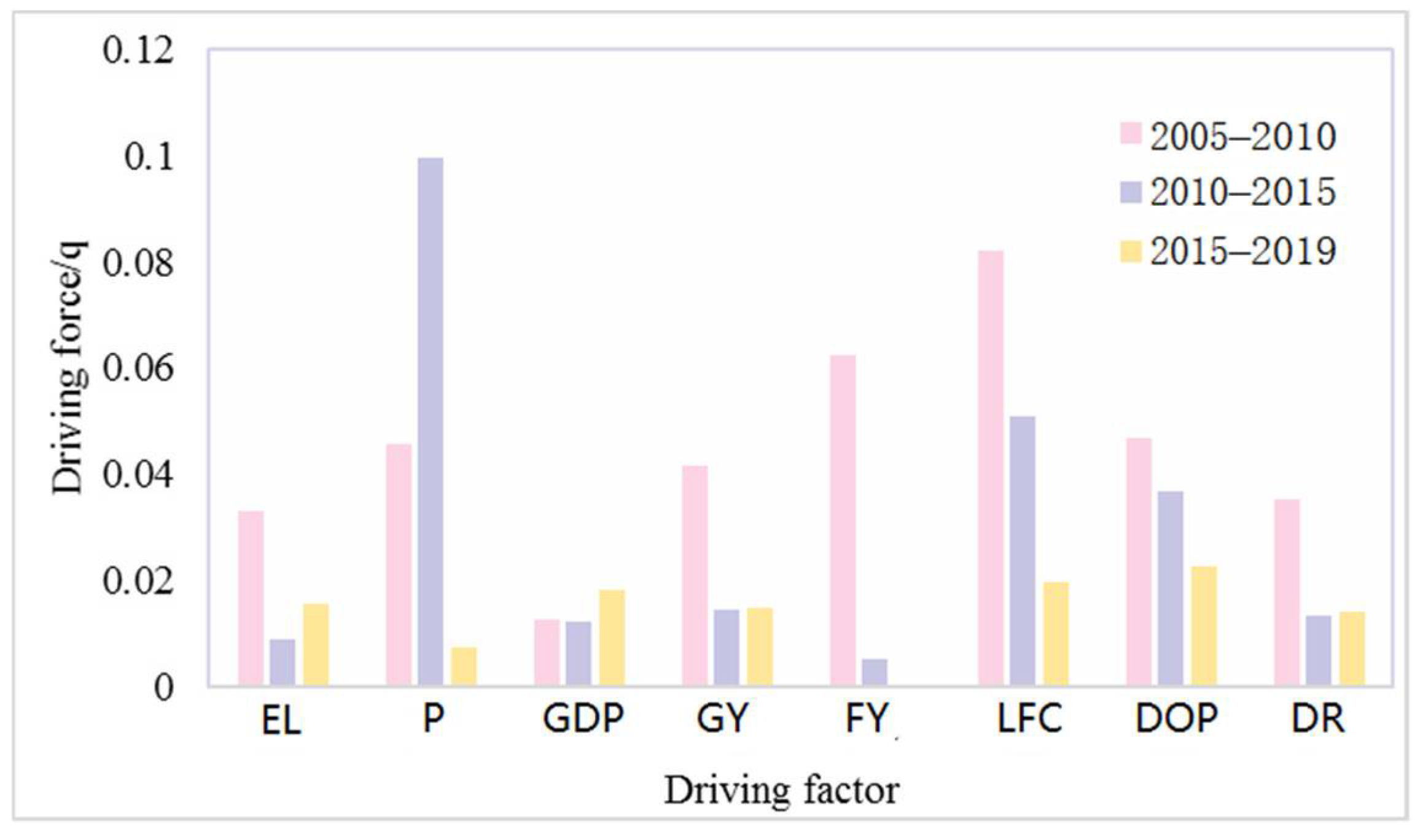

| Driving Forces | Coefficient | Standard Deviation | t | Robust_Pr | VIF |
|---|---|---|---|---|---|
| Elevation (EL) | 0.001727 | 0.013251 | 0.130354 | 0.898822 | 1.291934 |
| Precipitation (P) | 3.649503 | 1.44684 | 2.522396 | 0.017974 * | 6.575416 |
| Gross Domestic Product (GDP) | −0.000011 | 0.000004 | −2.690913 | 0.000011 * | 5.239569 |
| Grain yield (GY) | −0.010697 | 0.004044 | −2.645524 | 0.000000 * | 1.119108 |
| Fishery yield (FY) | 0.000281 | 0.000162 | 1.735454 | 0.013825 * | 7.478522 |
| Lake fluorine content (LFC) | −0.279368 | 0.184039 | −1.517983 | 0.088338 | 4.040279 |
| Distance to oil production (DOP) | 0.000012 | 0.00008 | −1.660495 | 0.102692 | 1.204025 |
| Distance to road (DR) | −0.000028 | 0.000017 | −1.660495 | 0.102692 * | 1.204025 |
| Joint F-Statistic | Jarque-Bera | Koenker (BP) | Joint Wald Statistic | ||
| 6.152154 | 34.837705 | 65.896048 | 254.815411 | 0.000000 * | |
| Period | Land Use Type | Unit | Grassland | Cultivated Land | Water Bodies | Bare Land | Marshland | Total |
|---|---|---|---|---|---|---|---|---|
| 2005–2010 | Grassland | km2 | 48.71 | 5.48 | 0.68 | 4.46 | 0.79 | 60.12 |
| Cultivated land | km2 | 4.02 | 20.26 | 0.11 | 0.97 | 0.06 | 25.42 | |
| Water bodies | km2 | 1.56 | 0.00 | 304.67 | 0.28 | 0.67 | 307.18 | |
| Bare land | km2 | 74.92 | 6.94 | 26.44 | 47.85 | 5.90 | 162.05 | |
| Marshland | km2 | 2.27 | 0.06 | 34.61 | 0.01 | 55.35 | 92.30 | |
| Total | km2 | 131.48 | 32.74 | 366.51 | 53.57 | 62.77 | 647.07 | |
| 2010–2015 | Grassland | km2 | 47.08 | 3.83 | 1.05 | 72.97 | 1.02 | 125.95 |
| Cultivated land | km2 | 6.63 | 21.43 | 0.33 | 22.36 | 0.65 | 51.40 | |
| Water bodies | km2 | 0.04 | 0.02 | 298.70 | 8.97 | 28.52 | 336.25 | |
| Bare land | km2 | 0.39 | 0.03 | 1.68 | 14.58 | 0.00 | 16.68 | |
| Marshland | km2 | 5.98 | 0.11 | 5.42 | 43.17 | 62.11 | 116.79 | |
| Total | km2 | 60.12 | 25.42 | 307.18 | 162.05 | 92.30 | 647.07 | |
| 2015–2019 | Grassland | km2 | 94.33 | 7.20 | 0.67 | 7.15 | 7.39 | 117.08 |
| Cultivated land | km2 | 23.93 | 39.53 | 1.00 | 1.27 | 9.87 | 75.93 | |
| Water bodies | km2 | 1.02 | 0.53 | 325.64 | 1.65 | 10.76 | 340.07 | |
| Bare land | km2 | 4.48 | 0.11 | 0.78 | 6.27 | 0.63 | 12.71 | |
| Marshland | km2 | 1.74 | 3.32 | 7.70 | 0.26 | 87.71 | 101.28 | |
| Total | km2 | 125.95 | 51.40 | 336.25 | 16.68 | 116.79 | 647.07 |
| Year | PD (#·100 ha−1) | LSI | CONTAG (%) | SHDI |
|---|---|---|---|---|
| 2005 | 1.5674 | 14.6818 | 61.0976 | 1.2754 |
| 2010 | 1.1142 | 13.1761 | 60.1488 | 1.3212 |
| 2015 | 1.787 | 13.8539 | 60.7797 | 1.2914 |
| 2019 | 0.7636 | 11.4509 | 99.8536 | 1.2902 |
Publisher’s Note: MDPI stays neutral with regard to jurisdictional claims in published maps and institutional affiliations. |
© 2022 by the authors. Licensee MDPI, Basel, Switzerland. This article is an open access article distributed under the terms and conditions of the Creative Commons Attribution (CC BY) license (https://creativecommons.org/licenses/by/4.0/).
Share and Cite
Li, Z.; Jiang, Z.; Qu, Y.; Cao, Y.; Sun, F.; Dai, Y. Analysis of Landscape Change and Its Driving Mechanism in Chagan Lake National Nature Reserve. Sustainability 2022, 14, 5675. https://doi.org/10.3390/su14095675
Li Z, Jiang Z, Qu Y, Cao Y, Sun F, Dai Y. Analysis of Landscape Change and Its Driving Mechanism in Chagan Lake National Nature Reserve. Sustainability. 2022; 14(9):5675. https://doi.org/10.3390/su14095675
Chicago/Turabian StyleLi, Zhaoyang, Zelin Jiang, Yunke Qu, Yidan Cao, Feihu Sun, and Yindong Dai. 2022. "Analysis of Landscape Change and Its Driving Mechanism in Chagan Lake National Nature Reserve" Sustainability 14, no. 9: 5675. https://doi.org/10.3390/su14095675
APA StyleLi, Z., Jiang, Z., Qu, Y., Cao, Y., Sun, F., & Dai, Y. (2022). Analysis of Landscape Change and Its Driving Mechanism in Chagan Lake National Nature Reserve. Sustainability, 14(9), 5675. https://doi.org/10.3390/su14095675






